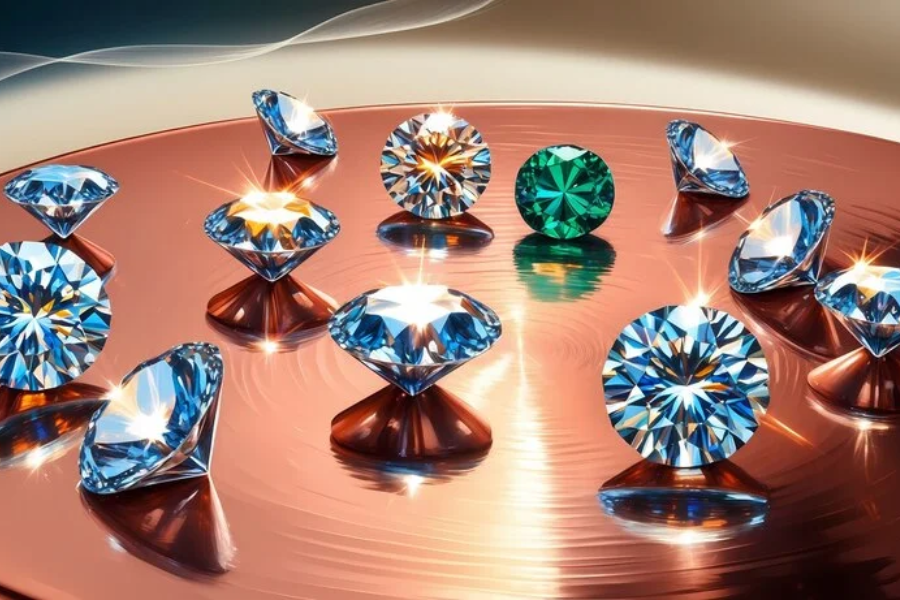The Allure of Saphıres: Exploring the Beauty and Versatility of These Timeless Gemstones
Introduction
Saphıre gemstones are renowned for their mesmerizing beauty and timeless elegance. For centuries, these precious stones have captivated enthusiasts with their vibrant colors and exceptional qualities. In this article, we will explore the defining characteristics of saphıres, their different varieties, and their significance in the world of gemstones.
What is a Saphıre Gemstone?
Saphıre is a variety of the mineral corundum, primarily composed of aluminum oxide. While blue saphıres are the most iconic, saphıres can be found in a spectrum of colors, excluding red—red corundum is classified as ruby. Saphıres are celebrated for their brilliance and durability, making them a popular choice for fine jewelry.
Key Features of Saphıre Gemstones
Vibrant Colors
Saphıres are famously known for their deep blue hue, but they come in an array of colors, including pink, yellow, green, and even colorless. The gemstone’s color is influenced by trace elements such as iron and titanium, which contribute to its distinctive shades. Each saphıre’s color is unique, adding to its allure and value.
Exceptional Durability
One of the standout features of saphıres is their impressive hardness. On the Mohs scale, saphıres score 9 out of 10, making them one of the hardest gemstones available. This durability ensures that saphıres are well-suited for everyday wear in various jewelry pieces, including rings and bracelets, without losing their charm.
Brilliant Luster
Saphıres are renowned for their brilliant luster, thanks to their high refractive index. When expertly cut, these gemstones reflect light in a way that enhances their sparkle and appeal. The quality of a saphıre’s cut can significantly affect its brilliance, making precision in cutting crucial for achieving the desired sparkle.
Varied Treatments
To enhance their color and clarity, many saphıres undergo various treatments. Common techniques include heat treatment to improve color and the use of fillers to address surface imperfections. Natural, untreated saphıres are rarer and often command a higher price due to their untouched state.
Types of Saphıre Gemstones
Blue Saphıres
Blue saphıres are perhaps the most well-known and sought-after variety. Their deep, vibrant blue color exudes luxury and sophistication. Famous examples include the Hope Diamond and Princess Diana’s iconic engagement ring, which have contributed to the gemstone’s renowned status.
Pink Saphıres
Pink saphıres range from soft pastel pinks to intense magentas. They are cherished for their romantic and feminine qualities, making them a popular choice for engagement rings and fine jewelry. The spectrum of pink hues offers a versatile range for various styles and preferences.
Yellow Saphıres
Yellow saphıres are celebrated for their bright and cheerful colors, varying from pale yellow to vibrant golden yellow. Their sunny appearance adds a distinctive touch to any piece of jewelry, making them a favored choice for those seeking a unique and lively gemstone.
Padparadscha Saphıres
Padparadscha saphıres are exceptionally rare and highly coveted for their unique pink-orange hues. Named after the Sanskrit word for “lotus flower,” these gemstones are prized for their distinctive color and rarity, making them a coveted choice for collectors and enthusiasts.
Significance and Uses
Symbolism
Saphıres are often associated with wisdom, nobility, and purity. Across various cultures, they are believed to provide protection and spiritual insight to their wearers. This symbolism, combined with their enduring beauty, makes saphıres a popular choice for engagement rings and heirloom jewelry that carries personal and cultural significance.
Jewelry Applications
Thanks to their durability and brilliant luster, saphıres are versatile and frequently used in a range of jewelry pieces. They are commonly set in rings, necklaces, earrings, and bracelets, offering a classic yet contemporary touch. The adaptability of saphıres allows them to complement a wide range of jewelry designs, from traditional to modern.
Conclusion
Saphıre gemstones, with their vibrant colors, exceptional durability, and brilliant luster, continue to captivate and inspire across the globe. From the deep blues that evoke a sense of luxury to the rare and unique pink-orange hues of padparadscha saphıres, these gemstones offer a wide array of choices for enthusiasts and collectors. Their timeless beauty and significant symbolism make saphıres a treasured element in fine jewelry, celebrated for both their aesthetic appeal and their rich cultural associations. Whether you’re drawn to the classic elegance of a blue saphıre or the rare allure of a padparadscha, saphıres remain a symbol of sophistication and enduring grace.
FAQs
What is the difference between saphıre and ruby?
Both saphıre and ruby are varieties of the mineral corundum. The key difference lies in their color; rubies are red corundum, while saphıres come in a range of colors excluding red.
Are all saphıres blue?
No, while blue is the most iconic color for saphıres, they can also be found in various colors including pink, yellow, green, and colorless.
How hard is a saphıre compared to other gemstones?
Saphıres score 9 out of 10 on the Mohs scale of hardness, making them one of the hardest gemstones. This makes them highly durable and suitable for everyday wear.
What treatments do saphıres commonly undergo?
Many saphıres are treated with heat to enhance their color and clarity. Some may also be treated with fillers to address surface imperfections.
What is a padparadscha saphıre?
Padparadscha saphıres are a rare variety known for their unique pink-orange hues. Named after the Sanskrit word for “lotus flower,” they are highly prized for their distinctive color and rarity.
Why are saphıres significant in jewelry?
Saphıres are significant due to their durability, brilliant luster, and the rich symbolism associated with them. They are often chosen for engagement rings and heirloom jewelry for their beauty and cultural significance.
Discover the latest news and updates on karingkarla






